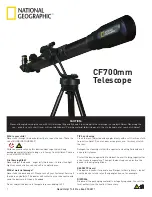
6
Loosen the Dec. lock knob and rotate the telescope optical tube
until it is parallel with the R.A. axis. The pointer on the Dec. set-
ting circle should read 90°. Retighten the Dec. lock lever.
Loosen the azimuth lock knob at the base of the equatorial
mount and rotate the mount so the telescope tube (and R.A.
axis) points roughly at Polaris. If you cannot see Polaris direct-
ly from your observing site, consult a compass and rotate the
mount so the telescope points North. Retighten the azimuth
lock knob.
The equatorial mount is now polar aligned for casual observ-
ing. More precise polar alignment is recommended for
astrophotography.
From this point on in your observing session, you should not
make any further adjustments in the azimuth or the latitude of
the mount, nor should you move the tripod. Doing so will undo
the polar alignment. The mount should be moved only about
its R.A. and Dec. axes.
use of the r.a. and Dec. slow-Motion
control cables
The R.A. and Dec. slow-motion control cables allow fine
adjustment of the telescope’s position to center objects within
the field of view. Before you can use the cables, you must
manually “slew” the mount to point the telescope in the vicinity
of the desired target. Do this by loosening the R.A. and Dec.
lock knobs and moving the telescope about the mount’s R.A.
and Dec. axes. Once the telescope is pointed somewhere
close to the object to be viewed, retighten the mount’s R.A.
and Dec. lock knobs.
The object should now be visible somewhere in the tele-
scope’s finder scope. If it isn’t, use the slow-motion controls to
scan the surrounding area of sky. When the object is visible in
the finder scope, use the slow-motion controls to center it.
Now, look in the telescope’s eyepiece. If the finder scope is
properly aligned, the object should be visible somewhere in
the field of view. Once the object is visible in the eyepiece, use
the slow-motion controls to center it in the field of view.
The Dec. slow-motion control cable can move the telescope a
maximum of 25°. This is because the Dec. slow-motion mech-
anism has a limited range of mechanical travel. (The R.A.
slow-motion mechanism has no limit to its amount of travel.) If
you can no longer rotate the Dec. control cable in a desired
direction, you have reached the end of travel, and the slow-
motion mechanism must be reset. This is done by first rotating
the control cable several turns in the opposite direction from
which it was originally being turned. Then, manually slew the
telescope closer to the object you wish to observe (remember
to first loosen the Dec. lock knob). You should now be able to
use the Dec. slow-motion control cable again to fine adjust the
telescope’s position.
tracking celestial objects
When you observe a celestial object through the telescope,
you’ll see it drift slowly across the field of view. To keep it in the
field, if your equatorial mount is polar aligned, just turn the
R.A. slow-motion control cable clockwise. The Dec. slow-
motion control cable is not needed for tracking. Objects will
appear to move faster at higher magnifications, because the
field of view is narrower.
optional Motor Drives for automatic tracking
An optional DC motor drive can be mounted on the R.A. axis
of the equatorial mount to provide hands-free tracking. Objects
will then remain stationary in the field of view without any
manual adjustment of the R.A. slow-motion control cable.
understanding the setting circles
The setting circles on an equatorial mount enable you to
locate celestial objects by their “celestial coordinates”. Every
object resides in a specific location on the “celestial sphere”.
That location is denoted by two numbers: its right ascension
(R.A.) and declination (Dec.). In the same way, every location
on Earth can be described by its longitude and latitude. R.A. is
similar to longitude on Earth, and Dec. is similar to latitude.
The R.A. and Dec. values for celestial objects can be found in
any star atlas or star catalog.
The R.A. setting circle is scaled in hours, from 1 through 24,
with small marks in between representing 10-minute incre-
ments (there are 60 minutes in 1 hour of R.A.). The lower set
of numbers (closest to the plastic R.A. gear cover) apply to
viewing in the Northern Hemisphere, while the numbers above
them apply to viewing in the Southern Hemisphere. The R.A.
coordinate indicator arrow is between the “R” and the “A” on
the plastic R.A. gear cover (see Figure 5); ignore the metal
pointer on the R.A. axis of the mount.
The Dec. setting circle is scaled in degrees, with each mark
representing 1° increments. Values of Dec. coordinates range
from +90° to -90°. The 0° mark indicates the celestial equator
(see Figure 5). When the telescope is pointed north of the
celestial equator, values of the Dec. setting circle are positive,
while when the telescope is pointed south of the celestial
equator, values of the Dec. setting circle are negative.
So, the coordinates for the Orion Nebula listed in a star atlas
will look like this:
R.A. 5h 35.4m Dec. -5° 27’
Little Dipper
(in Ursa Minor)
N.C.P.
Pointer
Stars
Polaris
Cassiopeia
Big Dipper
(in Ursa Major)
Figure 4: To find Polaris in the night sky, look north and
find the Big Dipper. Extend an imaginary line from the
two “Pointer Stars” in the bowl of the Big Dipper. Go
about five times the distance between those stars and
you’ll reach Polaris, which lies within 1° of the north
celestial pole (NCP).


























